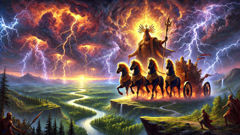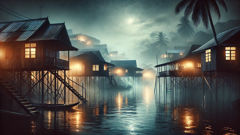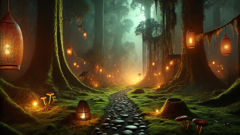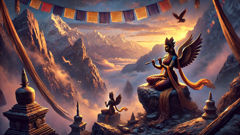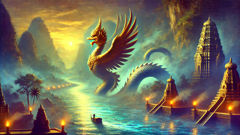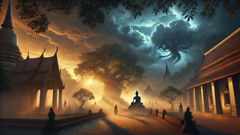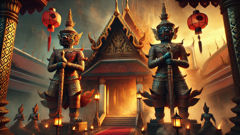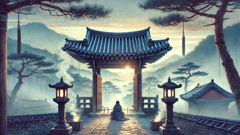Introduction
In the dawn-shrouded mists of ancient Ukraine, when the forests stretched unbroken from horizon to horizon and the rivers danced like silver serpents through wild meadows, there was a time when the people looked to the sky not just for weather, but for meaning. The rumble of thunder was not a mere sound—it was the voice of a god. The flash of lightning was a divine signal, a spark cast from the hand of a being whose power echoed across the ages. That god was Perun, the highest of all in the Slavic pantheon, the eternal thunderer, guardian of balance and the storm. His presence was felt in every crack of the heavens, every tempest that swept over the Carpathians, every trembling tree that bent before the wind. People whispered his name in awe and fear, for his moods shaped the fate of crops, herds, and entire villages. Perun was more than just a bringer of storms. He was the protector of order, wielding his mighty axe and riding a chariot drawn by fire-eyed steeds across the boiling sky. When night fell and darkness crept in, he watched over the world from his mountain throne, ever vigilant against the forces of chaos that threatened to spill from the underworld below. His legends were woven into the very earth—etched in the ancient stones, told in the wind’s song through pine needles, and remembered in the stories passed from elder to child beside flickering hearths. As spring awakened the land with thunderous rain, and summer storms rolled over golden fields, every flash and every crash was a reminder: Perun was near, and his tale was far from finished.
The Birth of Perun: Thunder’s First Roar
Before mortals built villages and sowed seeds, before even the first oak sent its roots deep into black Ukrainian soil, the sky itself was wild and untamed. In those primordial days, the universe trembled between order and chaos, and from that tension was born Perun. It’s said he arose from a mountain’s heart—a living bolt of energy, formed when the heavens cracked open and the world’s first storm broke across the land. His eyes burned with the fire of stars, his beard bristled like the storm clouds themselves, and his voice carried the weight of thunder across valleys and peaks.
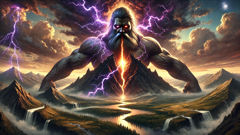
The people of early Ukraine lived close to nature, their lives shaped by the rhythm of storms and sunshine. They saw Perun’s hand in every natural wonder. When a great oak was struck by lightning, it was a mark of his favor or his warning. When rivers flooded in spring, feeding fields and forests, they believed it was Perun’s blessing—a sign that the land was alive under his gaze. In his chariot of bronze and flame, Perun’s travels across the sky marked the changing of seasons. His axe, heavier than any human could lift, was both a weapon and a tool. With it, he split clouds to release rain or sent down bolts to vanquish his enemies. The axe was sacred, and ancient tribes would carve its shape into wood and stone, wearing it as talismans for strength and protection.
Yet even Perun, mighty as he was, faced opposition. The world below teemed with forces of darkness and chaos—creatures that crept from the underworld, spirits that hungered for disorder. Chief among these was Veles, the serpent god of earth and water, who slithered through roots and rivers, ever seeking to rise up and challenge Perun’s rule. Their rivalry shaped the world: Perun above, Veles below, their eternal struggle reflected in the cycles of drought and deluge, storm and calm.
As the first humans settled, building wooden homes beneath the boughs of ancient forests, they offered bread and honey to Perun. They carved his image into their doorposts, hoping to keep storms gentle and rivers kind. Children grew up learning the songs of thunder and the stories of Perun’s battles. The land itself seemed to respond—oak trees, his sacred symbol, stood taller wherever his worship thrived. It was believed that to hear thunder while standing beneath an oak was to be touched by Perun’s presence, a rare blessing that could drive away sickness and misfortune.
It was in these early days, as the world took shape and the first storm raged over Ukraine’s endless plains, that Perun’s legend began—a story not just of power, but of the balance between wild nature and the fragile order that makes life possible.
The Battle With Veles: Storm Over the Dnipro
It wasn’t long before Perun’s rule was challenged by Veles, the shapeshifting serpent who slithered through the underworld and rose to the surface in times of chaos. Veles envied the sky’s freedom and the reverence mortals showed Perun. He coveted the treasures of the heavens and the order they brought, determined to drag them down into his watery realm.
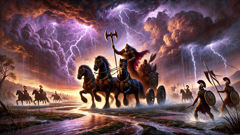
One fateful midsummer’s eve, when the air shimmered with heat and the rivers were swollen with melted snow, Veles made his move. Cloaked in mists and shadows, he crept up the sacred oak and stole the cattle, the wealth, and even the children of the gods. His laughter curled through fog and reeds, mocking Perun from every puddle and pool.
Thunder boomed as Perun awoke to the theft. In fury, he summoned his chariot, harnessing his fiery steeds. The sky turned dark with gathering storm clouds, and lightning licked the edges of the world. Across the vast Dnipro River, mortals watched in awe as the two gods prepared for war.
The battle raged for days and nights. Perun hurled his axe again and again, each throw a bolt of blinding energy that split trees and sent rocks tumbling. Veles, cunning and slippery, darted through rivers and rose as a serpent of smoke above the marshes. Every time Perun struck, Veles slipped away, hiding in another shadow or burrowing deeper into the earth.
Yet Perun would not relent. He chased Veles from the Carpathians to the Black Sea, shaking the earth with every step. The storms that lashed Ukraine during these days became legendary—lightning struck in rapid succession, and rain fell so heavily that rivers changed their course. Mortals huddled in their huts, whispering prayers and sacrificing bread at Perun’s altars for mercy.
In the end, it was not just strength but wisdom that won the day. Perun waited for Veles to surface at sunrise, knowing that the serpent god could not resist gloating when dawn revealed flooded fields and frightened villages. As Veles emerged in a swirl of mist on the banks of the Dnipro, Perun unleashed a final, furious bolt. The axe struck true, cleaving Veles’s illusion and sending him tumbling back to his underworld lair. With each victory, Perun restored order, returning stolen cattle and children to their rightful place. But he never destroyed Veles completely. The cycle would repeat: order and chaos locked in eternal dance, the world renewed by each clash of storm and serpent.
The Chariot of Fire: Perun’s Ride Across the Sky
Every storm in Ukraine was believed to be Perun’s journey across the heavens. His chariot was not just a vehicle but a force of nature—wheels forged from sun-bronze, harnesses of woven wind, and horses whose hooves sparked fire on the clouds. As he rode, the sky would tremble. Thunder rolled like distant drums, and flashes of lightning arced from horizon to horizon.

On nights when the moon was hidden and only the stars watched over the land, villagers would gather beneath their thatched roofs, listening for the distant rumble that signaled Perun’s passage. Some claimed to see him streak across the sky, a figure haloed in electric light, his axe aloft. Those who glimpsed his chariot spoke of its grandeur: flames trailing from its wheels, banners of storm cloud billowing behind, and sparks falling like shooting stars to the earth below.
Perun’s ride was more than spectacle. It was a promise—his eternal vigilance against the encroachment of chaos. When lightning struck an ancient oak or lit up a mountain peak, it was said Perun was testing his strength, renewing his bond with the land. During the fiercest storms, people believed Perun was fighting unseen spirits: forest demons, wandering ghosts, and the ever-returning Veles.
Children would run to windows during thunder, counting seconds between flash and crash. Parents told them that each bolt was Perun’s axe thrown in battle. If thunder was close, Perun was near—protecting the village or warning of misdeeds. Offerings would be left on windowsills: bread soaked in honey, wildflowers, carved wooden axes. These tokens were meant to honor Perun and ask for gentle rains, abundant harvests, and safety from floods.
The chariot’s path changed with the seasons. In spring, Perun’s ride brought rain to awaken the fields. In summer, his storms cooled parched earth and broke heatwaves. In autumn, the thunder signaled the end of the harvest, and people thanked him with feasts beneath ancient oaks. In winter, when storms were rare, the world seemed quieter, as if Perun rested atop his mountain, gathering strength for battles yet to come.
Through every storm, Perun’s chariot reminded mortals that nature’s fury was also its blessing. The same force that shattered trees could bring life to seeds. The same thunder that frightened children could protect them from darker things lurking just beyond the hearth’s light.
Conclusion
As storms fade and sunlight returns to the rolling plains and dense forests of Ukraine, the memory of Perun lingers in every thunderclap and echoing bolt of lightning. Though centuries have passed since his name was first whispered beneath ancient oaks, his spirit endures—in the strength of the land, in the courage of its people, and in the stories that refuse to be forgotten. Perun’s legend is more than myth. It’s a living thread that binds nature’s wild beauty to the hearts of those who walk these fields and forests today. In every seedling struck by spring rain, in every mountain shadow chased away by sunlight, his presence is felt. The cycles of order and chaos, storm and calm, continue their eternal dance, just as Perun and Veles once did above the mighty Dnipro. And so, each time thunder rattles the sky or lightning forks above the horizon, remember: it may just be Perun—eternal thunderer, guardian of the land—reminding us all of the power, wonder, and ancient magic that shaped Ukraine and its people.

